Project Management Assignment: Literature Review On Covid-19 Recovery Plan For NHS Nightingale
Question
Task: Write a project management assignment presenting a literature review on Covid-19 recovery plan for NHS Nightingale London.
Answer
Literature review- Response plan for a pandemic in NHS London
Introduction
According to the argument of Reed (2020) considered within this project management assignment,in 2020, the whole world was under the influence of the COVID-19 outbreak, which has affected the lives of people and the economy. The attack has caused severe health issues worldwide, and all the health officials were engaged in finding a response plan for this pandemic. At the beginning of 2020, WHO discovered these diseases and made the world aware of this pandemic situation. This pandemic has hampered lives and the economy in many ways. There were many lockdowns and other emergency measures taken by the government of each country to stop the spread of this pandemic situation.Additionally, a response plan was issued by the majority of the hospital to curb the spread of the pandemic situation. This section of the literature review will mainly focus on the response plan of COVID-19, which most hospitals have issued in global terms. Concerning that,the literaturewill highlight the initiatives taken by NHS Nightingale London to respond to the pandemic situation.Along with this the literature review will also be efficient to signify and evaluate all the project management initiatives taken by the project to implement all the planning’s in and efficient form of operation. Along with this the project best management activities encountered by the NHS London is also going to be demonstrated for proper fact finding.
Importance of strengthening the health system during a pandemic
According to OECD (2020), a pandemic response plan is essential from a global perspective in order to control the risk everywhere. The response plan includes both the financial and health systems of every country, which would help prepare the plan effectively. The crucial role in the development of finance in developing countries is so that they can strengthen their health system and prepare them for the effective response plan of COVID-19. But due to the rapid spread of this virus, it has seen a breakdown of the health architecture from a global perspective. Due to the lack of solid global architecture to respond to deadly viruses, in the initial phase, the mortality rate went on increasing at a rapid pace. Due to the in capabilities to fight the deadly virus, the health systems of developing countries have been primarily affected. Developing finance to strengthen the health system requires a shift and support towards focused investment in different transnational activities. It has always been observed that financing the health sector has a challenging aspect with which the global world has been mainly affected. As per Trent Herdmanet al. (2021), though earlier, WHO estimated that an additional USD 370 million would be required to strengthen the health system in the developing countries so as to achieve the sustainable development goal target of universal health care. The development of cooperation that has a significant role in the health sector has reached USD 26 billion in 2018 (De Val et al., 2021). Despite this increased mobilisation after the 2016 Ebola crisis, the investment in the pandemic preparedness and response plan was insufficient. This also indicated the proper attributable usages of project management for allocating such huge amounts to individual projects or directives. Without having proper planning and implementation there are very seldom number of chances coming in the path of the NHS London to examine and find the better approaches.
Concerning the pandemic situation, the development of cooperation must be the frontline for the battle, especially in developing countries like India. Since developing countries do not have much finance to meet all the requirements for fighting COVID-19, an immediate response is needed. As opined by Mahase(2021), though there are many issues while developing cooperation in COVID-19 as for the quick response from both bilateral and multilateral providers of development of collaboration that includes broader support for the economic activity and health-related measures, which has a total estimated of USD 250 billion. In order to raise such an amount, multilateral development banks have raised significant amounts of resources with over USD 120 billion. Additionally, bilateral donors like the European Union have responded that they will provide a EUR of 15 billion in order to tackle this virus. Developing countries require proper technical support and other capabilities to fight this deadly virus. Development cooperation must focus more effectively upon quick wins and build successful models to ensure that the funds are not diverted into unnecessary areas.
Though investing in the first line of defence is not enough for the response plan of such deadly viruses, development cooperation must invest more in the line of defence in the health system, which can stop the impact of COVID-19 to some extent. It has been seen that in developing countries like India, the crisis has raised questions in the capacity of healthcare. It has led governments to shift all their resources away from efforts for tackling other services. All the health security efforts for the effective prevention, alert, and response to the outbreaks like COVID-19 needs to be poured similarly while strengthening healthcare (Oliver, 2021). However, the global lockdown during the peak of the pandemic situation has helped to reduce the number of people affected by the pandemic a lot. Hence, though it is essential to strengthening the health care system yet, it is necessary that financing the health system is one of the significant forces for war against COVID-19. The framework below has stated the community engagement required for the COVID health response plan.
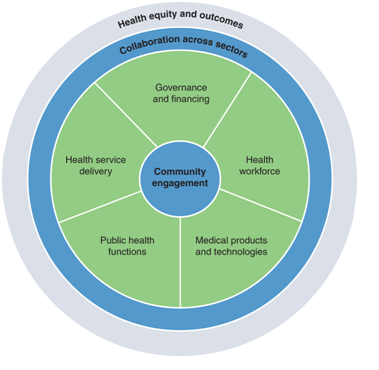
Figure 1: Community engagement in COVID-19
(Source: Oliver, 2021)
UK’s strategy for COVID-19 response
According to Bmj (2019), UK’s responses mainly to COVID-19 was earlier neither well prepared nor it have been adequately maintained. As Evans (2021) stated, the World health organisation said on January 9th 2020, that COVID cases were only 59 in UK, but soon after one-year gap, the pandemic cases were rising strongly. On January 21st, 2021, all the health organisations felt a need for a national strategy for COVID-19 response and pandemic preparedness. After the rising cases UK government have discussed a public emergency on 30th January. After that there was frequent lockdown to reduce the rate of infected people but due to the lower level of PPE kits doctors and nurses has been facing issues to handle the patient effectively. After this dysfunction process UK government have prioritised in developing health and wellbeing of the public while rebuilding the disempowerment. They are as follows:
Goal 1: Stay at home orders
With the repeated order of stay at home and marinating social distancing are some of the response strategies which has been taken by British government. As stated by Sinhaet al. (2021), the government is also taking adequate measures, so that vaccine shots are given to people from all communities, from tribal people to all people who need this vaccine. In the US, the government has accelerated the pace of vaccination by encouraging all the local communities and states to move through the priority groups more effectively. One of the critical response indicators is that the government has constantly been sharing the data of daily active cases in every city to support the people to fight this deadly virus.
Goal 2: Developing a safe vaccination campaign
It has been one of the responsibilities of the national government to ensure that the vaccine which has been developed should reach effectively to all the people. It is necessary that the government needs to execute an aggressive vaccination strategy that will mainly focus on the immediate action for converting vaccines and vaccinations. One of the major goals being providing and circulating accurate and scientifically correct information is essential for people to maintain open communication for the public and all the stakeholders. Many governments have established a COVID-19 response structure where the actual decision making is driven by equity and science. Development of safe vaccination campaign is another effective measure that has been taken by UK. There are various camping which are done by the UK leaders in order to create the awareness of taking vaccination which will help the people to reduce the impact of the pandemic (Sinhaet al., 2021), the government is also taking adequate measures, so that vaccine shots are given to people from all communities, from tribal people to all people who need this vaccine.
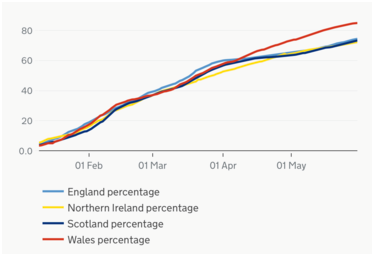
Figure 2: Vaccination campaign completion
(Source: Sinhaet al., 2021)
Goal 3: Reducing the spread of pandemics through expanding testing, workforce and clear heath standards.
Even after the vaccination camps rams up effectively, it has been observed that to control the virus, the government has speeded up the production of masks and tends to reduce the pandemic situation with effective treatment and clear all the health standards. With the effective use of technologies, the government has boosted the production of masks and increased the capabilities in the health system to mitigate the spread of COVID-19 with clear public health standards. Scaling and expanding the testing procedure is another central area where the government has increased the standards. Additionally, the national government has started the effective distribution of tests and broadened the access to testing in different parts of the world, especially in developing countries. Additionally, UK government have taken effective steps to improve the health testimonials.
Goal 4: Emergency relief and public communication
In response to the COVID-19 pandemic, the UK government have introduced different health and economic measures in order to reduce the impact. In such crisis period numerous laws have been started to curb the rate of COVID-19 pandemic. After the confirmed cases of pandemic in January, UK introduces many advices for the travellers and thus began contact tracing although later it has become in effective (Cowper, 2020). With much effective emergency relief and defence production act the UK government have responded to the particular timelines in public health measures which are being introduced and lifted.
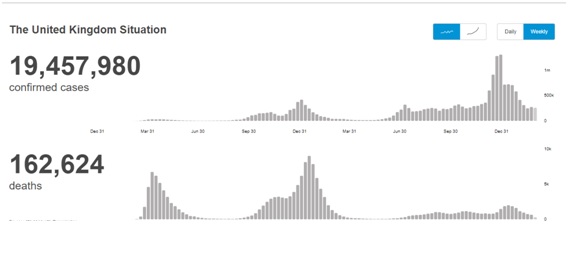
Figure 3: Covid UK cases
(Source: Who, 2020)
Goal 5: Safely reopening schools and travelling while protecting workers
After several criticism which has been faced by British government back in 2020 due to high mortality rate in COVID-19, one of the national strategies that the government is trying to implement is reopening the schools and businesses. It is necessary to unify the federal investment for rapid testing. In the UK, the government is mainly trying to ensure that all the students and educators get vaccines to resume learning under protocols. Additionally, the government has also taken the initiative to support the child care centres. Due to the pandemic situation, the child care centres have faced many problems, so some of the funds are raised to help these workers.
Goal 6: Protecting frontlines who are exposed to risk
After the first wave in 2020 UK government was negligible towards the safety kits and other PPE production to keep the front liners safe. But after frequent protest through doctors and other nurses it have raised huge conflict to protect this frontline who handle patient. The main aim of the task force will be to convene the national experts for health equity and thus provide recommendations to mitigate the health inequities faced in the COVID-19 period. The government ensures equitable access to the PPE kits and therapies and vaccines is accessible to the people effectively. Prioritising diversified and inclusive representation is the main aim of the national government.
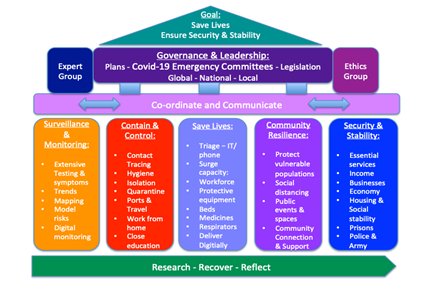
Figure 4: National strategy for a recovery plan
(Source: Cowper, 2020)
Response of World Health organisation
As per the discussion made by Who (2021), COVID-19 response mainly tends to address the pillars of strategic preparedness and response plan. The SPRP (strategic preparedness and response plan) of WHO has provided a midterm report where the SPRP plan has been put into action from February to august 2021. The organisation has estimated that it will require a fund of $1.96 billion to support other organisations in order to combat the phases of the pandemic situation. But as of September, the organisation has faced a funding gap but ultimately tried to effectively tackle the pandemic (Day, 2020). The organisation has convinced many donors and supporters and thus have been able to raise the amount by March 2022. Below diagrams have represented the total revenue earned by its donors.
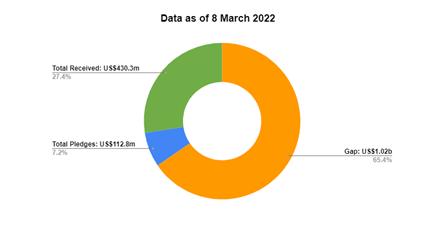
Figure 5: Revenue structure
(Source: Thornton, 2020)
According to Daynes,Gerlis and Singh(2021), WHO's primary strategy is to prepare the SPRP plan in 2021 to reduce the impact of the pandemic in developing countries. The response plan for 2021 has been built up based on all the data gathered throughout the 2020 situation. The project has been built on all the new challenges and achievements necessary to address after the new variant has started to infect the people. Additionally, the SPRP plan, which is the central part of the response plan, has included a road map where the people, as well as countries, need to travel towards an equitable, safe and effective delivery of diagnostic and vaccination campaigns being the central part of the overall strategy to tackle the situation. WHO has also delivered a proper advising plan to the health workers who are the main focal point of the pandemic situation and needs to balance the service delivery needs while preserving and accessing the essential health services that have been deployed for COVID-19 vaccines (Thornton, 2020). While addressing all the risks faced by the front lines of the health authority, which have stated practical guidance and training planning so that they can take safety precautions while dealing with COVID patients. WHO has dedicated several learning resources to support the clinical roles and tasks to support the COVID-19 vaccine rollout needed for the individual health workers EPI-WIN, the information network for epidemics, has been opened by WHO to make the people aware of the genuine news and latest information concerning the pandemic. Furthermore, implementing infodemic management has helped the communities and patients to manage the overabundance of the information and thus trust the sound source.
Need for setting NHS nightingale hospital London
In response to the pandemic situation, the UK government has set up NHS Nightingale hospital London temporarily by NHS England for the COVID-19 case. Within nine days, the government has planned to initiate this hospital which will take care of the COVID-19 patients. The hospital has been made initially to support nearly 500 patients with the potential to increase it to 4000 beds in the future. As per News (2020), it has stated that the COVID-19 pandemic failed so drastically in all parts of the UK that it was necessary to build an NHS nightingale hospital within nine days span. Within a small duration of nine days, this hospital was constructed with 500 fully equipped beds and all the technical amenities necessary for COVID patients. All the hospital wards were built under the care and effective technological equipment, which was both luxurious and comfortable for the patients. The hospital has a capacity of 4000 patients, and 16,000 doctors have been appointed all across the wards. All the nursing staff has been accumulated from other nearby hospitals, and the medical students have been trained to effectively serve the patients in the hospital. The news has stated that cabin crews will have security clearance and will be introduced with first aid training to effectively address the severity of COVID-19.
In contrast, NHS Nightingale has been built to respond to the emergency need of the COVID-19 situation; Sabbagh (2020) have argued that Nightingale's emergency hospital may not be needed as urgently as it was expected. As other hospitals in the UK are coping better with the diseases, constructing Nightingale with such a massive capacity of 4000 beds is not an essential part of the response plan to deal with the pandemic situation. The covid 19 scenario has also enlarged the requirement of completing the hospital within a very short time. The whole planning and implementation have been completed by the help of project management initiatives. But the most influential change which is been brought in by the project management initiative is the way of developing the whole building with aligning the covid protocols like distancing and all. Even the most critical part of operation with the project management work is to accumulate al the technological instruments within such a minor time without having clear demographic for logistics support and activities. The argument states that intensive care units were needed much urgently rather than the making of a hospital bite the political sources and NHS have addressed to increasing the capacity of the hospital rather than increasing the emergency capacity which the people much needed as a part of an immediate recovery plan for the pandemic situation. Additionally, it has been charged that the London branch of NHS Nightingale has not responded to the emergency capacity, which is essentially required than the other parts of NHS Nightingale. Across the capital, nearly 900 people died after being tested positive, which have raised several questions for the NHS after developing such a luxury hospital. Hence, it has proved that London needs to cope better with this additional facility of NHS Nightingale than expected. The repeated national lockdown has grown the concern for the testing process and supply of protective equipment, which was missing in NHS Nightingale, has put the hospital in a difficult situation.
Response plan of NHS nightingale
Ford (2020) have stated that earlier, the military people were mainly required for fire, flooding and snow. Still, the use of this pandemic situation has triggered one of the most significant national military responses. Clinical staff has been addressing the front lines of the UK in response to the pandemic situation. Along with that, it has been observed that military aid has brought much needed and practical civil engineering skills that are the key factors mainly for ensuring the NHS. The primary purpose of standing joint command is primarily to coordinate defence's contribution in UK operations to support the government. With the practical help of SDJ, NHS has been able to support and undertake delivery of the Nightingale for the temporary facilities. Nightingale has ensured that by gaining support from military responses, they can increase the construction capacity of the hospital, which is necessary to effectively address the emergency of the pandemic.This is been accumulated through the help of project management activities and protocols.Siva Ananda Live (2021) argued that though the construction of seven Nightingales in different locations across the UK was much appreciated as it has combat against the COVID-19 situation, one of the issues is funding (Thornton, 2020). The construction was built with an investment of more than 530 million, which was regarded as white elephants for most of the people and thus found it unnecessary after the COVID situation was reduced. Many of the other health experts have also stated that the NHS has used a lot of health care associates who have created an issue in the local hospitals of the cities.
But still, after all this criticism, NHS Nightingale London has been able to establish a proper recovery plan for the citizens all across Europe. One of the biggest challenges in the initial stages of the construction was the lack of trained working healthcare's. NHS Nightingale has mitigated this by providing training to the volunteers on-site and has motivated them to be ready for any consequences. But all the work has been accomplished with greater efficiency and through is due to its adoptability towards project management technologies and associations. As per England (2021), after the recent news about a new variant of COVID-19, which is Omicron, the NHS has made new plans initiated in Nightingale facilities. Setting up Nightingale surge hubs at the hospitals across the country has been a part of the potential wave of Omicron admission. The seats have improved themselves to NHS resilience if the capacity of the infected people starts increasing drastically. The hospitals have used 4000 super surge beds for the patient to reduce the impact of COVID-19 as a part of the recovery plan.
UK project management plan
Phase 1: Current situation
COVID-19 being an invisible threat that has spread in almost every country worldwide. Among all the countries the UK has the maximum number of patients especially in intensive care and thus it has been estimated to double by 4 days. The below exponential graph showcased the different approaches in COVID-19 that have been shown for the NHS where it has been contained effectively. In the UK, the scientific advisory group for emergencies, which has been assessed, states that at the beginning of an epidemic it has between 2.7 and 3.0 where each person having this disease is spreading to three other people. So in such a situation the government has invested heavily in order to tackle the diseases. NHS capacity has increased significantly with 3000 new critical beds across the UK and has a daily rapid antigen test which has been increased by 1000% during April. Additionally, the UK government is trying to deal with the impact of COVID-19 and to support the families of the people who have died. As mentioned by Hezam (2021), over the past few months in between March and July, the pandemic has impacted the lives and livelihood of the regular people, which have adversely affected the lives of the vulnerable people and have further worsened their lives. It was seen that the families who were suffering from violence in the relationship as well as discrimination, unequal opportunity to get access to the basihusc minimum needs of the everyday living of the common people have been majorly affected from the outburst of the pandemic and are still suffering from the brunts caused due to the pandemic. The outbreak of the Covid has pointed out prominently the crisis existing in the different sectors of the world. It has also expanded the hunger crisis and the epicentre of the common people's hunger situation (Dora and Kumar, 2020). The food insecurity of the common people might rise due to conflicts, economic crises and natural disasters compared to the pre-pandemic period. All these factors have a static set of impact making ability over the country too but by the proper implementation of plans and activities through the help of project management orientation along with alternative responses have become the key strike force for the UK.
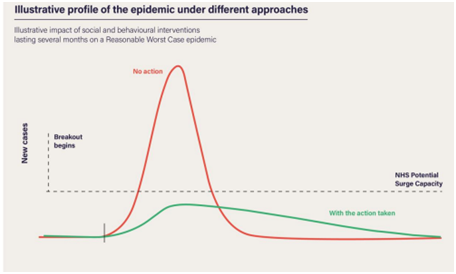
Figure 6: Different approaches
(Source: Sekalala et al., 2020)
Phase 2: Smarter controls
Under this phase the UK government has told people about the easy to minimise the spread of disease through continuing good hygiene practices: hand washing, regular disinfecting of the surfaces and social distancing which are touched by others. The below stated steps for adjustment to the current measures that include strict conduction to safely move from each step to next. It is necessary that new adjustments are to be made with the use of existing restrictions and taking some of the further adjustments. Reopening of the outdoor space and activities are subject to low risk of spread rather than the indoor spaces so the government has closed gyms and cinemas. As per Lawson McDowall, McCormack and Tholstrup (2021), the UK government has decided to move into a new phase it recognises that the level of threat which has been poised by the virus is varying across the population and thus the government started home isolation in order to reduce the impact. With increase in sales of oxy-meters and other smart controls to diagnose the virus effectively.
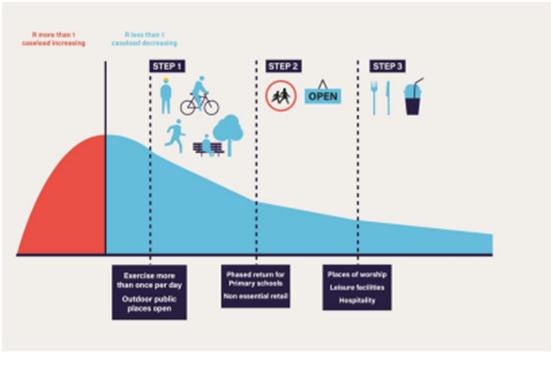
Figure 7: Steps in smart controls
Source: (Jones and Ventevogel, 2021)
Phase 3: Reliable treatment
Though the above two phases have described the short-term recovery plan which the UK government has initiated in order to reduce the impact of diseases. But soon the government is planning to make a more sustainable solution and treatment to treat these diseases though it has several other variants. Though there are 70 countries who are involved in the race of vaccination development, the UK was the first who made the human trial. Researchers all across the UK and NHS London are trying to develop new areas of treatment to make such a reliable treatment to cure these diseases unlike all other epidemics like HIV and AIDs. Though from the second phase the UK government has been able to connect with the society and roll out the treatments effectively. All the human controls and initiative are approached to be changed due to the processionary requirement of covid 19 destruction.
Due to the school closure resulting from the lockdown, the earnings of the future generation and the student's human capital were adversely affected, and it has affected the mental and psychosocial health. It was seen that majority of the effect of the pandemic was on the working population of the informal sector. Employees losing jobs, lack of access to inputs required during production, and access to the market affected the informal sector. Hence, these low-income countries should try to improve their health system and their capacity to implement the economic stimuli required in packaging. In order to increase the global supply and so that the medical pieces of equipment could be accessed quickly, multilateral collaboration is being used.
UN response to COVID-19
Due to the outbreak of the COVID-19 pandemic, not only the health sector was in crisis, moreover the economic sector, the human rights sector, the security of common people was also in crisis. These crises that were evident within the economy showed prominently the inequality gap as well as the fragilities existing among the different countries. Bosa et al. (2022) mentioned that to improve the situation of the economy, the whole society and the government should come into agreement for taking proper measures. Hence in order to deal with this situation, the UN launched their UN Comprehensive Response to COVID-19. Hence in order to maintain the pandemic situation, the objectives that need to be done are – to deliver the global responses to collaborate with every employee, to reduce the chances of vulnerability if any further pandemic occurs, build resilience towards the future shock and also reduce the severity as well as the inequality gaps that were being exposed due to the pandemic.
Since the pandemic has been affecting thousands of lives by spreading the disease among millions of common people, it has significantly impacted the global economy and caused uncertainty about the future. However, the UN has mobilised early as well as comprehensively by implementing the global health response, thereby continuing and at the same time have expanded the lifesaving assistance of humanitarian, the introduction of instruments in order to get a rapid response for the socioeconomic impact and also for the formulating a policy agenda (Jewett et al., 2021). These comprehensive responses have also provided operational support to the government as well as the partners present across the globe. All the initiated supporting activities are being approached or completed through the help of different project management activities and thoughts.
The comprehensive response laid by the UN has emphasised the three pillars used while operating, which are:
(1) To deliver the coordinated, comprehensive and large-scale health responses
(2) ToAdopt the policies that can focus on damaged socioeconomic, human rights and the humanitarian aspect of the crisis caused due to the pandemic.
(3) To formulate a recovery procedure to enhance the economy's condition.
As per the on which UN comprehensive response, there are six aspects for the plan are:
Liquidity:The countries can fight back with the resources available to them against the damage caused by the pandemic, hence the UN is trying to keep the financial stability in order to focus on the development and also to formulate a recovery plan so that both the current as well as the future generation can benefit from it.
Debt: The UN focuses on reducing the debt crisis caused as a result of the pandemic as well as sustainable development for the future (Sachs et al., 2020). The UN has been promoting to focus on the vulnerability towards the debt to developing countries and support them by providing free resources in order to save the lives and their livelihoods across the world. Action by the private creditors: The UN has been engaging with the private creditors to get a proper, timely, and effective solution to pay back the old debt and reduce the cost incurred on the investors.
External Finance: The UN has improved inclusive growth and created employment. They have also committed to reducing the remittance fees towards the ideal value or close to zero.
Rebuilding different and in a better way: The UN has been developing recovery policies for enhancing sustainability and inclusivity and keeping the development goals to meet the social and economic impact caused on the people due to the pandemic (Thornton, 2020).
Ending of illicit financial flow: UN has been taking steps to expand the fiscal state and restore the domestic resources to prevent base erosion and profit shifting and giving paramount importance to the digital economy.
Comparison of health responses in different countries
During the outbreak of the COVID-19, the US, the UK and Canada were the countries first to experience the pandemic, moreover they did not take preventive measures from the very beginning. As has been mentioned by LindingerSternart et al. (2021), even in Canada, there were no mandatory lockdowns to be followed which were one of the significant reasons the spread happened so rapidly. Moreover, the death cases were much lower in Canada than in Ireland despite mandated lockdown, where the causes of death were very high. Hence the guidelines and the mandates required for the lockdown and the reopening were essential factors for the seriousness of the spread of the virus during the first wave.
It was also observed that all the countries except for the US made sure that the payments for the testing of the COVID-19 were being paid, whereas it was free for all to test in the US, moreover the treatment was not being guaranteed for all (Raamkumar, Tanand Wee, 2020). There is not much information about insurance coverage followed in the US to access the treatment for the disease. Moreover, it was also observed in the case of Ireland and the US that the financial barriers are why either of the countries does not provide proper coverage in the healthcare sector. Hence, both countries should focus on their health coverage after the pandemic is over.
It was being observed that all the countries were facing difficulties while making the testing capacity and while implementing the supporting tests. Thereby, these countries have been facing shortages at the initial point in their supplies as well as have faced various other challenges regarding the testing of the virus. Desson et al.(2020) pointed out that it is also being observed that both the contact tracing and isolating, which were responsible for breaking the chain for the virus transmission, have been very difficult to break. As seen in England, though, they could test numerous people simultaneously. Still, issues like tracing systems or app failures have hence exposed many of the common people towards the infection. Therefore, the testing procedure's effectiveness should be changed to detect the symptoms effectively and for utilising the lab capacity present within the research institutes. Proper training integrating the tracing systems as well as clusters identified from the resources is essential to improve the tracing ability.
It was also reported that the lack of workers within the healthcare sector and the shortage of the PPE kit might also contribute more over to the spread of the virus within some countries. This challenge has been widespread in all nations. Since there was no ample supply of the PPE kit, contamination happened very fast, and hence the spread rate of the infection increased (Galasso et al., 2020). As there were not enough workers available at the pandemic time, therefore, to cope with the pressure of the patients waiting, it is also a possibility that some of the employees would have treated the patients while they were themselves affected by the virus. This might have spread the disease further. This has been prevalent in the countries like the US and the UK, where they faced shortages of supplies as well as workers. Therefore, the procedures should be tested and monitored regularly.
References List
Bmj.com. (2019). UK’s response to covid-19 “too little, too late, too flawed” | BMJ. [online] Available at: https://www.bmj.com/company/newsroom/uks-response-to-covid-19-too-little-too-late-too-flawed/
Bosa, I., Castelli, A., Castelli, M., Ciani, O., Compagni, A., Galizzi, M.M., Garofano, M., Ghislandi, S., Giannoni, M., Marini, G. and Vainieri, M., (2022). Response to COVID-19: was Italy (un) prepared. Health Economics, Policy and Law, 17(1), pp.1-13. https://www.cambridge.org/core/services/aop-cambridge-core/content/view/7946552DE995F34E06F426BCBEF494A5/S1744133121000141a.pdf/response_to_covid19_was_italy_unprepared.pdf
Cowper, A., (2020). Covid-19: Testing times for the government—but not for NHS staff. BMJ, 369. https://scholar.archive.org/work/w6k3jdaod5dw5ihfonnfhlkj6y/access/wayback/https://www.bmj.com/content/bmj/369/bmj.m1433.full.pdf
Day, M., (2020). Covid-19: Nightingale hospitals set to shut down after seeing few patients. https://www.bmj.com/content/369/bmj.m1860.full
Daynes, E., Gerlis, C. and Singh, S.J., (2021). The demand for rehabilitation following COVID-19: a call to service providers. Physiotherapy, 113, pp.A1-A3.https://www.ncbi.nlm.nih.gov/pmc/articles/PMC8141823/
De Val, J., Sohal, G., Sarwar, A., Ahmed, H., Singh, I. and Coleman, J.J., (2021). Investigating the challenges and opportunities for medicines management in an NHS field hospital during the COVID-19 pandemic. Project management assignmentEuropean Journal of Hospital Pharmacy, 28(1), pp.10-15. https://ejhp.bmj.com/content/ejhpharm/28/1/10.full.pdf
Desson, Z., Weller, E., McMeekin, P. and Ammi, M., (2020). An analysis of the policy responses to the COVID-19 pandemic in France, Belgium, and Canada. Health Policy and Technology, 9(4), pp.430-446. https://www.sciencedirect.com/science/article/pii/S2211883720300940
Dora, M. and Kumar, M., (2020). Operational improvement programs and humanitarian operations. Production Planning & Control, pp.1-4. https://www.tandfonline.com/doi/pdf/10.1080/09537287.2020.1834137
England, N. (2021). NHS England» NHS plans new Nightingale facilities in response to Omicron. [online] England.NHS.UK. Available at: https://www.england.nhs.uk/2021/12/nhs-plans-new-nightingale-facilities-in-response-to-omicron/
Evans, E.J.,( 2021). Social Workers and the National Strategy for the COVID-19 Response and Pandemic Preparedness. Health & social work, 46(2), pp.89-91. https://www.ncbi.nlm.nih.gov/pmc/articles/pmc8135714/
Ford, S. (2020). Building the Nightingale hospitals: Engineering on the fast track | Nursing Times. [online] Nursing Times. Available at: https://www.nursingtimes.net/news/hospital/building-the-nightingale-hospitals-engineering-on-the-fast-track-23-06-2020/
Galasso, V., Pons, V., Profeta, P., Becher, M., Brouard, S. and Foucault, M., (2020). Gender differences in COVID-19 attitudes and behavior: Panel evidence from eight countries. Proceedings of the National Academy of Sciences, 117(44), pp.27285-27291. https://www.pnas.org/content/pnas/117/44/27285.full.pdf
Hezam, I.M., (2021). COVID-19 Global Humanitarian Response Plan: An optimal distrimoreoverion model for high-priority countries. ISA transactions. https://www.ncbi.nlm.nih.gov/pmc/articles/PMC8040533/ Jewett, R.L., Mah, S.M., Howell, N. and Larsen, M.M., (2021). Social cohesion and community resilience during COVID-19 and pandemics: A rapid scoping review to inform the United Nations research roadmap for COVID-19 recovery. International Journal of Health Services, 51(3), pp.325-336. https://journals.sagepub.com/doi/pdf/10.1177/0020731421997092 Jones, L. and Ventevogel, P., (2021). From exception to the norm: how mental health interventions have become part and parcel of the humanitarian response. World Psychiatry, 20(1), p.2. https://www.ncbi.nlm.nih.gov/pmc/articles/pmc7801844/ Lawson McDowall, J., McCormack, R. and Tholstrup, S., (2021). The use of cash assistance in the Covid 19 humanitarian response: accelerating trends and missed opportunities. Disasters, 45, pp.S216-S239.https://onlinelibrary.wiley.com/doi/pdfdirect/10.1111/disa.12524
Lindinger Sternart, S., Kaur, V., Widyaningsih, Y. and Patel, A.K., (2021). COVID 19 phobia across the world: Impact of resilience on COVID19 phobia in different nations. Counselling and psychotherapy research, 21(2), pp.290-302. https://www.ncbi.nlm.nih.gov/pmc/articles/PMC8013921/ Mahase, E., (2021). Omicron: NHS is on “war footing” as Nightingale hubs are announced in England. https://www.bmj.com/content/375/bmj.n3159.short
News, B. (2020). Coronavirus: How NHS Nightingale was built in just nine days. [online] BBC News. Available at: https://www.bbc.com/news/health-52125059
OECD. (2020). Strengthening health systems during a pandemic: The role of development finance. [online] Available at: https://www.oecd.org/coronavirus/policy-responses/strengthening-health-systems-during-a-pandemic-the-role-of-development-finance-f762bf1c/
Oliver, D., (2021). David Oliver: Were Nightingale units and fever hospitals ever workable responses to covid-19. BMJ, 374. https://www.bmj.com/content/374/bmj.n2013.short
Raamkumar, A.S., Tan, S.G. and Wee, H.L., (2020). Measuring the outreach efforts of public health authorities and the public response on Facebook during the COVID-19 pandemic in early 2020: cross-country comparison. Journal of medical Internet research, 22(5), p.e19334. https://www.jmir.org/2020/5/e19334/
Reed, S., (2020). Resuming health services during the Covid-19 pandemic What can the NHS learn from other countries.http://allcatsrgrey.org.uk/wp/download/health_services/resuming-health-services-web.pdf
Sabbagh, D. (2020). Nightingale emergency coronavirus hospital may not be needed as urgently as expected. [online] the Guardian. Available at: https://www.theguardian.com/world/2020/apr/03/nightingale-emergency-coronavirus-hospital-london
Sachs, J.D., Karim, S.A., Aknin, L., Allen, J., Brosbøl, K., Barron, G.C., Daszak, P., Espinosa, M.F., Gaspar, V., Gaviria, A. and Haines, A., (2020). Lancet COVID-19 Commission Statement on the occasion of the 75th session of the UN General Assembly. The Lancet, 396(10257), pp.1102-1124. https://www.ncbi.nlm.nih.gov/pmc/articles/PMC7489891/
Sekalala, S., Forman, L., Habibi, R. and Meier, B.M., (2020). Health and human rights are inextricably linked in the COVID-19 response. BMJ Global Health, 5(9), p.e003359. https://gh.bmj.com/content/bmjgh/5/9/e003359.full.pdf Sinha, R., Aramburo, A., Deep, A., Bould, E.J., Buckley, H.L., Draper, E.S., Feltbower, R., Mitting, R., Mahoney, S., Alexander, J. and Playfor, S., (2021). Caring for critically ill adults in paediatric intensive care units in England during the COVID-19 pandemic: planning, implementation and lessons for the future. Archives of Disease in Childhood, 106(6), pp.548-557. https://adc.bmj.com/content/106/6/548.abstract
Siva Anandaciva (2021). Was building the NHS Nightingale hospital worth the money The king's fund. https://www.kingsfund.org.uk/blog/2021/04/nhs-nightingale-hospitals-worth-money Thornton, J., (2020). Covid-19: the challenge of patient rehabilitation after intensive care. BMJ, 369. https://www.isprm.org/wp-content/uploads/2020/05/Covid-19-the-challenge-of-patient-rehabilitation-after.pdf Trent Herdman, M., Seers, T., Ng, C., Davenport, R., Sibley, S., Mannion, S., Balasegaram, S. and Redmond, A.D., (2021). Clinical frailty as a vital characteristic of the patient population of the NHS Nightingale North West COVID-19 temporary emergency field hospital: cohort study April to June 2020. JRSM Open, 12(10), p.20542704211046435. https://journals.sagepub.com/doi/pdf/10.1177/20542704211046435
Who. int. (2021). How is WHO responding to COVID-19 [online] Available at: https://www.who.int/emergencies/diseases/novel-coronavirus-2019/who-response-in-countries
Who.int. (2020). The United Kingdom: WHO Coronavirus Disease (COVID-19) Dashboard With Vaccination Data. [online] Available at: https://covid19.who.int/region/euro/country/gb












